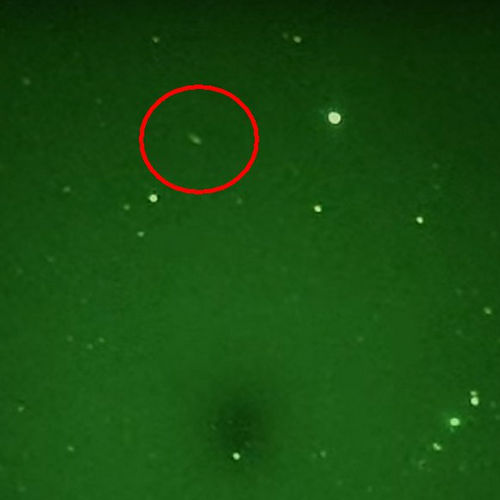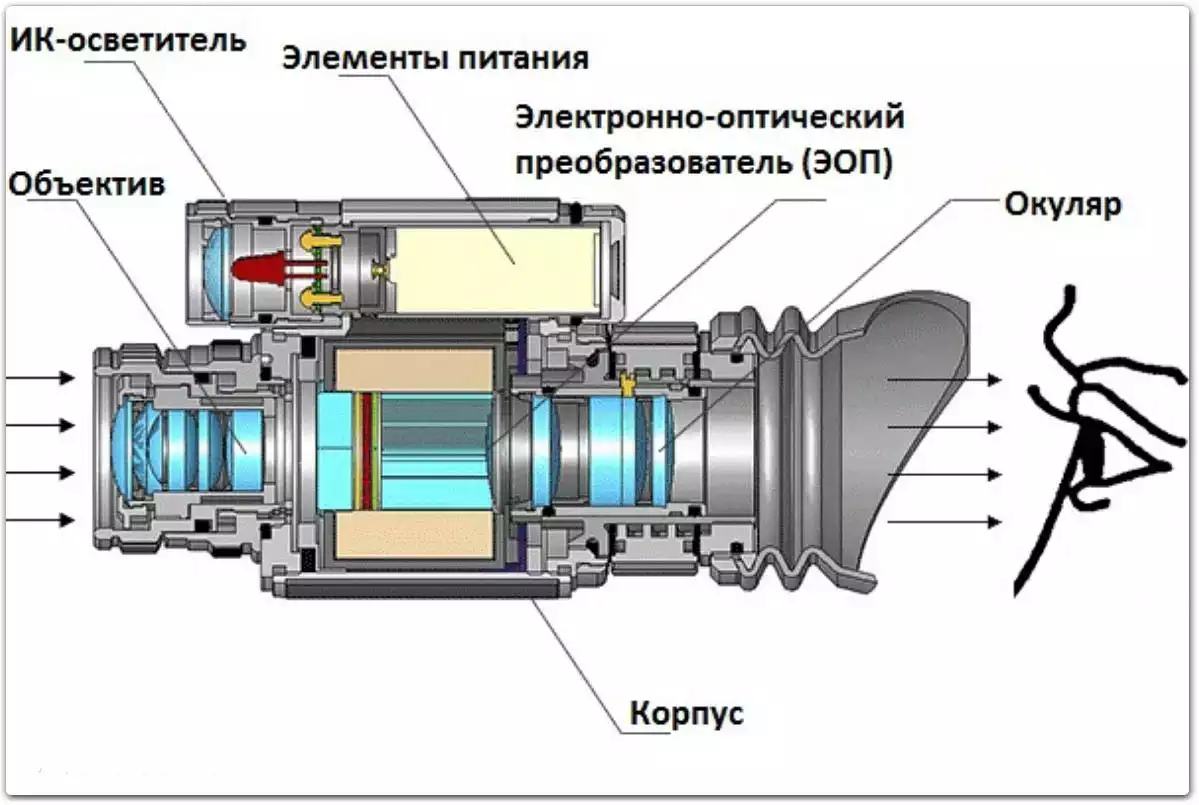On the other hand, mystical creatures and objects themselves periodically get into the lenses of CCTV cameras operating in night mode. In this article, we will try to understand what can help to see these devices and how effective they are with such use.
Night vision devices are a class of optical-electronic devices that provide the operator with an image of the area (object, etc.) in conditions of insufficient illumination. According to the variants of execution, night vision devices are divided into built-in (for example, in surveillance cameras), separate (for visual observation without recording), as well as made in the form of consoles to photos and/or video cameras.
The daily mode of the video camera allows you to convey the maximum of information (color picture, clear contours, etc.), but is not suitable for low light conditions. When you go into night mode in the camera matrix, the color usually turns off, which allows you to increase the sensitivity of the device up to 50%. It should be remembered that no night vision device can function in absolute darkness, so these devices often use special infrared lighting.
There are several principled approaches to building night vision devices:
- Amplification of very weak visible light. The idea is implemented in electro-optical converters (EOP) and, to some extent, in modern video cameras for security systems with so-called night mode.
- Observation in near-infrared (wavelength 0.7.1.5 microns). As a rule, sensitivity in the infrandy range is a side effect for EOP and CCD-matrix. However, in the near IR there are no natural sources of radiation, except the sun, and in complete darkness such devices will not see anything. Therefore, their design often uses special sources of illumination, invisible to the naked eye, but easily visible even on the camera of the phone (for example, infrared spotlights based on LEDs).
- Observation in the average (heat) infrared range (wavelength 7.15 microns). In this range radiate bodies heated to the temperatures of our world: from minus 50 degrees Celsius and above. Such devices are called thermal imaging. They show a picture of the temperature difference and do not require additional illumination.
- Observation in the ultraviolet spectrum. The absence of natural sources of ultraviolet light (except the sun) and the almost complete absence of artificial sources of ultraviolet light invisible to the naked eye inhibit the spread of night vision devices based on this principle.
Night vision device scheme
The device consists of one or two lenses, eyepieces and an electronic-optical converter located between them. It is the electro-optical converter that allows you to see in the dark.
The Electro-Optical Converter (EOP) is a vacuum photoelectronic device that enhances the light of visible and near-infra signals. It has a high sensitivity and is able to give an image in very low light.
Passive (unlit) night vision devices are historically the first such devices and are widely used today. Since they are sensitive only in the near-infrared range, their operation, as well as the operation of video cameras with semiconductor matrix, requires the presence of lighting (e.g. night sky light or infrared spotlights). The EOP light gain rate ranges from a few thousand to tens of thousands of times.
There are several generations of electro-optical converters:
- Generation 1 EOP has a glass vacuum flask with a photocathode sensitivity of 120 - 250 mAh/lm. The increase in light is approximately 120 - 900 times, the resolution in the center is 25 - 35 str/mm.
- The EOP of generation 1 q already have a metal-ceramic converter with a sensitivity of photocathode 200 - 300 mAh/lm. The increase in light is brought to 1200 or more times, the resolution throughout the image reaches 35 - 45 str/mm.
- EOP Generation 2 have a metal-ceramic converter with a sensitivity of a photocatode 240 - 400 (usually at least 350) mAH/lm. The increase in light is 20,000 - 40,000 times, resolution 32 - 56 (average about 50) str/mm.
- EOP generation 2 q have a metal-ceramic converter with a sensitivity of photocatode 240 - 400 (usually at least 350) mAH/lm. The increase in light is 25,000 to 50,000 times, resolution 38 - 70 str/mm.
- Generation 3 EOP is built on the basis of a semiconductor material - arsenide galium. The sensitivity of the phototomod reaches 900 - 1600 mAh/lm. The increase of light reaches 60,000 - 100,000 times, the resolution is brought to 50 - 78 str/mm.
Let's describe the principle of the night vision device with EOP in low light conditions, when the sensitivity of the human eye is not enough to examine the surrounding objects in detail.
The light reflected from the object gets to the entrance lens of the optical system of the device - the lens. The lens collects the light falling on it and focuses the image of the object on the surface of the main element of the night vision device (electro-optical converter), called a photocathode. The task of the EOP is to amplify several hundred or thousands of times the light flow that entered it through the lens, and to transfer the image of the object to the fluorescent screen. The image on this screen and examines the observer through the second part of the optical system - the eyepiece.
There are also digital night vision devices, which are based not on electro-optical converters, but on CCD-matrix (LCDs - devices with charge communication). Such devices have excellent characteristics for the strengthening of light (up to 60,000 times), much cheaper to manufacture than devices based on EOP, are not afraid of lighting and can be used in the daytime without any restrictions. Modern semiconductor video cameras are capable of giving an image in the illumination of the scene up to 0.0005 suites.
The sensitivity of night vision devices in the near-infrared (IR) range allows to organize invisible human eye illumination of the scene (for example, infrared LEDs). To avoid color errors, conventional household video cameras are supplied with a special filter that cuts off the IR image. Cameras for security systems, as a rule, do not have such a filter, but in the dark there are no natural sources of radiation in the near infrared range, so without illumination such cameras will not show anything.
The IR lighter serves as an additional light source and is used when the natural light of the surrounding space is insufficient. Ir LEDs are used as a light source in infra-ing lights, and more expensive laser diodes of the IR range are used less often. It should be noted that laser radiation poses a danger to vision, so the use of laser diodes in IR lights is prohibited by the law of some countries. The night vision device mode with the IR lighter on is called active.
The range of the IR lighter depends on its power:
- Miniature lights (capacity no more than 5 mW) allow you to navigate at a distance of 20 - 30 meters, for example, indoors or in a small yard.
- The 10 mW lighter will give a distance of 50 to 70 meters, 20 mW - already 120 - 150 meters.
- Powerful LED IR lighters (100 - 200 mW), sometimes called IR lanterns, as well as laser IR lights are more often used as a second, additional illumination. They usually have a removable design and focus mechanism, allowing to collect light in a narrower beam and increase the distance of observation to 300 - 500 meters.
A working IR lighter from the side usually looks like a light of a lit cigarette, but there are also such lights that are not visible to the human eye.
What can we see with night vision devices? Everything is the same that we can see in the light: any objects of the material world reflecting light. Such devices can be effective when tracking down in the dark of some animal (yeti, chupacabra, etc.), when shooting people at night (for example, with their help you can see a prankster sneaking in the dark) or flying without illumination UFO.
Thus, the use of night vision devices can provide researchers of paranormal phenomena with additional visual information that can help to identify the phenomenon, or even determine the cause of its appearance.
Log in or register to post comments


